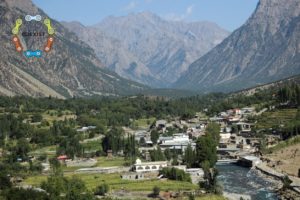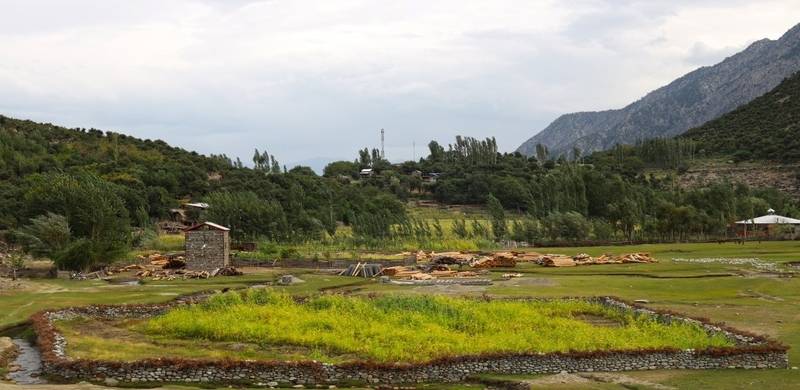
It all started about six months ago, when someone mentioned thousands of years old rock carvings along the River Indus. It is my hobby to explore and discover new places and hence I began to research and about the rock carvings from whatever material was available to me. During my research, I found that these carvings were present in Tangir and Darel valleys of Gilgit Baltistan. Thus, I started looking forward to visiting these places at the first available instance. That opportunity came to me a couple of weeks back in September 2019. When I visited Tangir, I found that the valley had a certain aura of mystique to it along with it being a bit controversial.
Tangir Valley
Crossing Babusar Top from Kaghan valley and traversing Indus Kohistan, we reached Chillas. From Chillas, it is about a two-and-a-half hour drive to Tangir Valley via Besham.
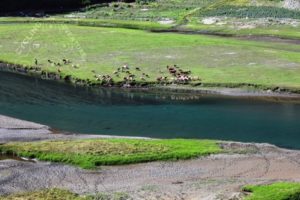
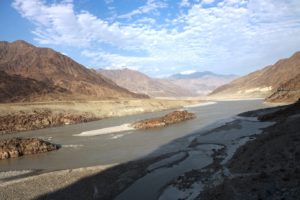
Last year, about a dozen girls schools were burnt and the area was considered a hot bed of militancy. Not satisfied with the area’s limited media coverage, and the lack of tourism facilities with not a single hotel in the valley, the only option left with me was through local support, which I found on social media. I wanted to experience things first-hand and wanted to know about the local culture of the Tangir valley. To my amazement, things were pretty different from what was depicted about the place and I found one of the friendliest people of Pakistan, absolutely gorgeous sceneries, food and fruits. My experience confirmed that one should not believe all that they hear, read or watch on media.
The journey begins:
After an uneventful travel through Kaghan Valley, I crossed over from Babusar Top and reached Chillas. There I met Javed for the first time, who was my host in Tangir Valley and who I had befriended on social media.
My first shock came as we reached a place called Thalpan. At this place, there is a cluster of Indus Rock carvings and I was expecting a well preserved site. I had read that USAID had given a $17.9million grant for their protection and socio-economic development. WAPDA was also doing something in this regard since it is expected that most of these rocks would drown under the lake of Diamer Bhasha Dam. There were other grants from some international bodies including World Monument Fund and Prince Claus Fund. However, what nature could not destroy over thousands of years, we have destroyed with some liberal paintings over these rocks. There was not even a fence around these rocks or other such rocks which I encountered. However, that is another story which warrants a full coverage so I will leave this here.
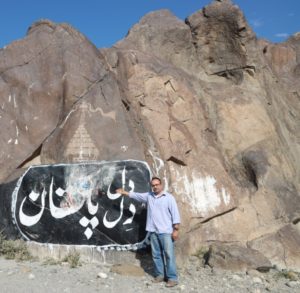
On the way to Tangir Valley, the scenery along the Indus was beautiful. I just wished if the boulders could speak and tell us something about the different travelers who traversed this route through centuries but soon my thoughts were brought to reality by Javed announcing that we had to cross the bridge to enter the valley, it was already around sunset and in the quick fading light we entered Tangir valley.
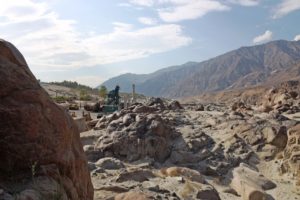
Road to Tangir :
After crossing the bridge, there was a police check post where one had to register themselves to cross further. The policemen were very cordial and repeatedly offered us tea but we made a hasty departure as the light was fading and I wanted to capture some of the valley. Initially, the change in scenery was not that drastic except that the muddy Indus was now a clear blue, splashing Tangir River on our right.
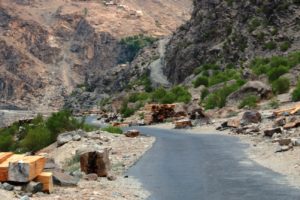
My objectives for this survey were;
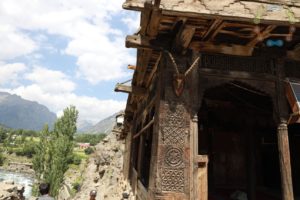
There are a couple of schools in the valley, but the quality of teachers lacks and the fact that the schools are understaffed means that a lot can be done in this direction.
There is an overwhelming desire of the valley people for education. Like in Swat, the few miscreants were taken care of by the army and similar to Swat, the local population in Tangir does not want such characters back. They want progress, and education is the single most powerful tool for this. The day I reached the valley, we had a Jirga with the notables and everyone was of the same opinion. Fear should take the back seat now and we should come forward in helping them in education so that the next generation integrates with the society.

As much as we may desire, the government may not be able to handle everything, hence our contributions are required.
Medical Camp:
On an emergency basis with the help of friends, we are establishing a medical camp from 7th to 15th October, 2019, taking along a general physician and an ophthalmologist. I could clearly see that the beautiful children of the valley were malnourished. A clearer picture would come out after this camp. We are still looking for a lady doctor for the camp.
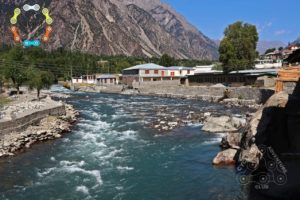
The area has huge tracts of forests, beautiful lakes, streams with trout and a valley still unexplored. People are extremely friendly and would not let you pass without asking you to have tea or food. The area has a hundred years old mosque, whose Imam gave me his well-used woolen cap and I knew he did not have another one. I just could not let go of their local drink made from Khobani. It is important to note that Tangir Valley is as safe as any other place in Pakistan for tourism and you will be certainly surprised by its raw beauty.
There were certain apprehensions I had. First and foremost would be extensive logging. I was told that there is a certain government policy in which they open access for picking up old logs. The ingenious people use this opportunity to cut and transport new trees as well by dyeing them with tea etc. to make them appear old. Recently, before this policy was put an end to, extensive logging was done in the valley. The contradiction that the local people do not want logging yet it is being done at this level was evident.
Even after the publication of pictures of fresh-cut white logs, the only explanation the chief conservator of forests, Gilgit Baltistan, could offer was that the labelled trees in the pictures were years old.
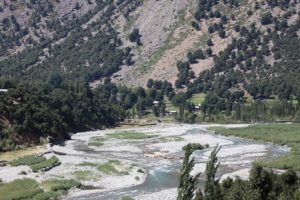
My other apprehension would be that by promoting tourism for the area, I may bring more damage to their rich and simple culture. Unregulated tourism would introduce plastic waste in the valley and increase waste. My suggestion would be to make some regulations before formally opening up the valley for tourist activities.
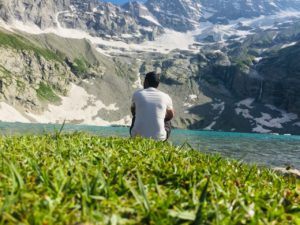
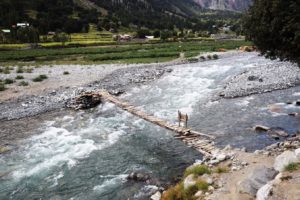
Tangir Valley
Crossing Babusar Top from Kaghan valley and traversing Indus Kohistan, we reached Chillas. From Chillas, it is about a two-and-a-half hour drive to Tangir Valley via Besham.

Kaghan Valley

The mighty Indus along the Karakoram Highway
Last year, about a dozen girls schools were burnt and the area was considered a hot bed of militancy. Not satisfied with the area’s limited media coverage, and the lack of tourism facilities with not a single hotel in the valley, the only option left with me was through local support, which I found on social media. I wanted to experience things first-hand and wanted to know about the local culture of the Tangir valley. To my amazement, things were pretty different from what was depicted about the place and I found one of the friendliest people of Pakistan, absolutely gorgeous sceneries, food and fruits. My experience confirmed that one should not believe all that they hear, read or watch on media.
The journey begins:
After an uneventful travel through Kaghan Valley, I crossed over from Babusar Top and reached Chillas. There I met Javed for the first time, who was my host in Tangir Valley and who I had befriended on social media.
Javed had a burning desire to introduce his valley to me instantly and he kept conversing about conservation, archeology and the protection of birds and animals of his hometown. Time passed quickly as these were topics of my interest as well and we quickly bonded into a new friendship.
My first shock came as we reached a place called Thalpan. At this place, there is a cluster of Indus Rock carvings and I was expecting a well preserved site. I had read that USAID had given a $17.9million grant for their protection and socio-economic development. WAPDA was also doing something in this regard since it is expected that most of these rocks would drown under the lake of Diamer Bhasha Dam. There were other grants from some international bodies including World Monument Fund and Prince Claus Fund. However, what nature could not destroy over thousands of years, we have destroyed with some liberal paintings over these rocks. There was not even a fence around these rocks or other such rocks which I encountered. However, that is another story which warrants a full coverage so I will leave this here.

Defaced rock carvings
On the way to Tangir Valley, the scenery along the Indus was beautiful. I just wished if the boulders could speak and tell us something about the different travelers who traversed this route through centuries but soon my thoughts were brought to reality by Javed announcing that we had to cross the bridge to enter the valley, it was already around sunset and in the quick fading light we entered Tangir valley.

A batching plant adjacent to Thalpan site
Road to Tangir :
After crossing the bridge, there was a police check post where one had to register themselves to cross further. The policemen were very cordial and repeatedly offered us tea but we made a hasty departure as the light was fading and I wanted to capture some of the valley. Initially, the change in scenery was not that drastic except that the muddy Indus was now a clear blue, splashing Tangir River on our right.

Logs at the entrance of the valley
My objectives for this survey were;
- Help in opening and running of schools (both girls and boys )
- Documenting the medical infrastructure and requirements
- Documenting illegal logging and poaching
- Observing archaeological sites
- Assessing local population’s acceptance to change and their friendliness
- Introducing the valley to the rest of the world for tourism

A more than 100 years old mosque
There are a couple of schools in the valley, but the quality of teachers lacks and the fact that the schools are understaffed means that a lot can be done in this direction.
There is an overwhelming desire of the valley people for education. Like in Swat, the few miscreants were taken care of by the army and similar to Swat, the local population in Tangir does not want such characters back. They want progress, and education is the single most powerful tool for this. The day I reached the valley, we had a Jirga with the notables and everyone was of the same opinion. Fear should take the back seat now and we should come forward in helping them in education so that the next generation integrates with the society.

Local Jirga discussing the issues of Tangir Valley
As much as we may desire, the government may not be able to handle everything, hence our contributions are required.
The valley does have a government hospital, but I could not locate any doctor that day. I have been told that there is no qualified doctor in the valley and that there is not a single lady doctor or midwife and that’s a huge problem for the people of the area.
Medical Camp:
On an emergency basis with the help of friends, we are establishing a medical camp from 7th to 15th October, 2019, taking along a general physician and an ophthalmologist. I could clearly see that the beautiful children of the valley were malnourished. A clearer picture would come out after this camp. We are still looking for a lady doctor for the camp.

Main Tangir Market along the river
Tangir Valley is pristine! Its water is blue, land is fertile and there is no usage of pesticides in all of the valley. Everything is organic and darn tasty. There is no concept of desi or Farmi Murghi as there are only desi murghis and eggs. There is no plastic pollution, no wrappers flying around, even in the small marketplace. The children would never run up to you asking for money; they have great self-esteem.
The area has huge tracts of forests, beautiful lakes, streams with trout and a valley still unexplored. People are extremely friendly and would not let you pass without asking you to have tea or food. The area has a hundred years old mosque, whose Imam gave me his well-used woolen cap and I knew he did not have another one. I just could not let go of their local drink made from Khobani. It is important to note that Tangir Valley is as safe as any other place in Pakistan for tourism and you will be certainly surprised by its raw beauty.
There were certain apprehensions I had. First and foremost would be extensive logging. I was told that there is a certain government policy in which they open access for picking up old logs. The ingenious people use this opportunity to cut and transport new trees as well by dyeing them with tea etc. to make them appear old. Recently, before this policy was put an end to, extensive logging was done in the valley. The contradiction that the local people do not want logging yet it is being done at this level was evident.
Even after the publication of pictures of fresh-cut white logs, the only explanation the chief conservator of forests, Gilgit Baltistan, could offer was that the labelled trees in the pictures were years old.

Cut trees stored along the Tangir river
My other apprehension would be that by promoting tourism for the area, I may bring more damage to their rich and simple culture. Unregulated tourism would introduce plastic waste in the valley and increase waste. My suggestion would be to make some regulations before formally opening up the valley for tourist activities.

Gacher Lake, Tangir

A precarious bridge

